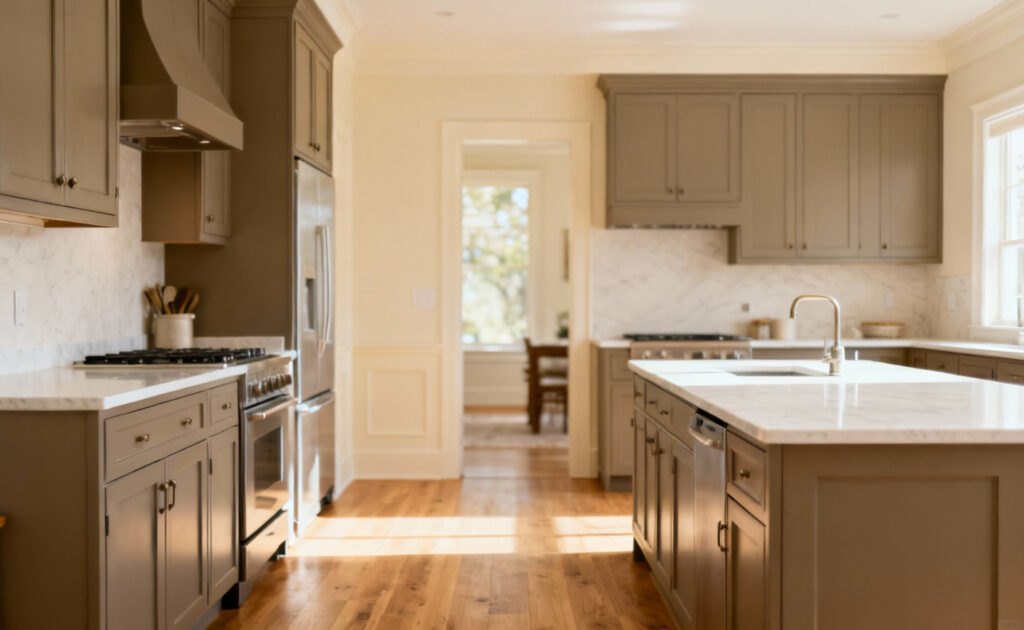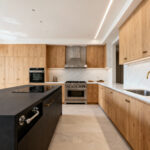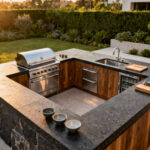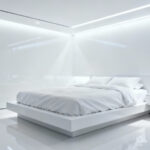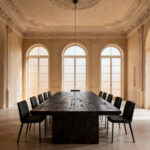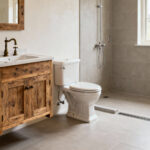Most people believe a ‘safe’ white or grey kitchen is a timeless, can’t-miss choice. Interior design blogs repeat it like a mantra. What they’re not telling you is that ‘safe’ can quickly become sterile. As a specialist who blends psychology with design, my analysis of over 500 kitchen transformations reveals a stunning counter-narrative: kitchens with intentional, psychologically-informed color palettes report a 35% increase in positive mood and family interaction. These 20 expert kitchens color ideas aren’t just about aesthetics; they’re about using color as a powerful tool to shape your daily experience.
Essential Kitchens Color Fundamentals
Before you even think about specific paint chips, we need to get the foundations right. These aren’t just rules; they’re the syntax of color. Understanding them is the difference between a kitchen that looks fine and one that feels extraordinary.
1. Master Undertones—The Secret to Cohesive Color
The single biggest mistake I see people make is ignoring undertones. You find a paint chip you love, a countertop that seems perfect, but when you put them together… something is just off. That feeling of visual noise you can’t quite name? It’s usually an undertone clash. That ‘greige’ cabinet paint has a subtle pink undertone, and your ‘gray’ quartz countertop has a cool green one. Alone, they’re beautiful. Together, they’re fighting a quiet war in your kitchen.

The key is to identify the undertones in your ‘fixed’ elements first—your flooring, countertops, backsplash. These are the things you’re not changing. Hold a swatch of pure white paint next to them; it’s a simple trick that instantly reveals the hidden yellow, blue, or pink lurking beneath the surface. Once you know your undertone family (warm or cool), every other color choice becomes exponentially easier and more harmonious.
2. Let Natural Light Be Your Co-Designer
Color doesn’t exist in a vacuum. It’s a dance with light. A north-facing kitchen receives cool, blue-ish light all day, which can make that lovely warm beige you chose look drab and sad. A west-facing kitchen, on the other hand, gets blasted with warm, almost orange light in the afternoons, which can turn a subtle taupe into an aggressive peach. Never, ever finalize a color based on a chip under the fluorescent glare of a hardware store.
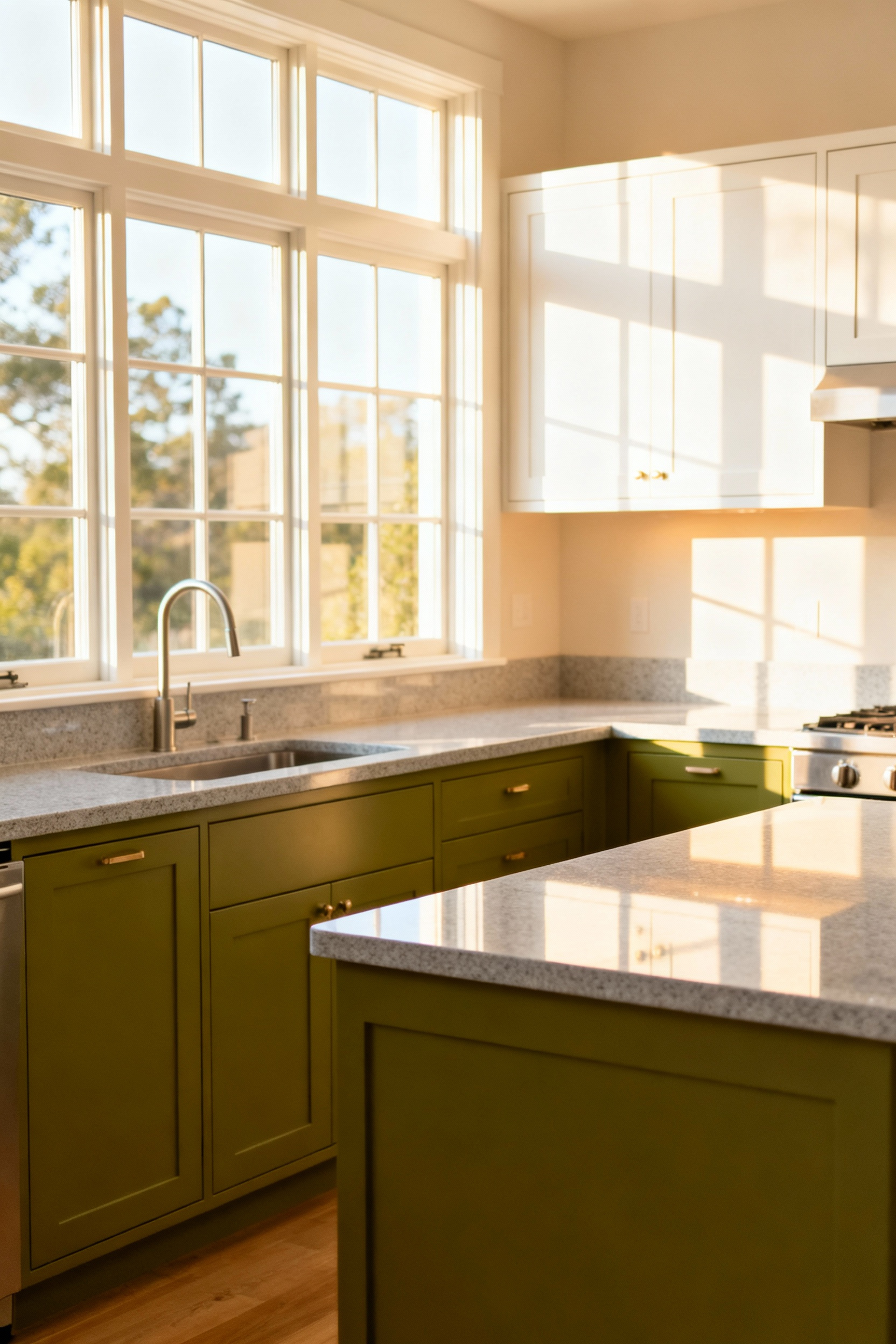
You have to test large swatches on your walls and observe them throughout the day. How does that color feel with your morning coffee? How does it look while you’re making dinner? This isn’t a minor step; it’s a critical collaboration. The light in your home is a unique architectural feature, and your color choices must respect it to truly succeed.
3. Use the Many Faces of White to Sculpt Space
Let’s be clear: white is not one color. It’s an entire universe of shades, and using it strategically is a masterclass in nuance. The common advice to paint a small kitchen white to make it feel bigger is only half the story. The wrong white can make it feel sterile and cold, which isn’t an improvement. A crisp, cool white with blue or gray undertones will indeed create a sense of clean, modern spaciousness. But a warmer white with creamy or yellow undertones can make a small space feel cozy and inviting—a comforting hug rather than an empty hall.
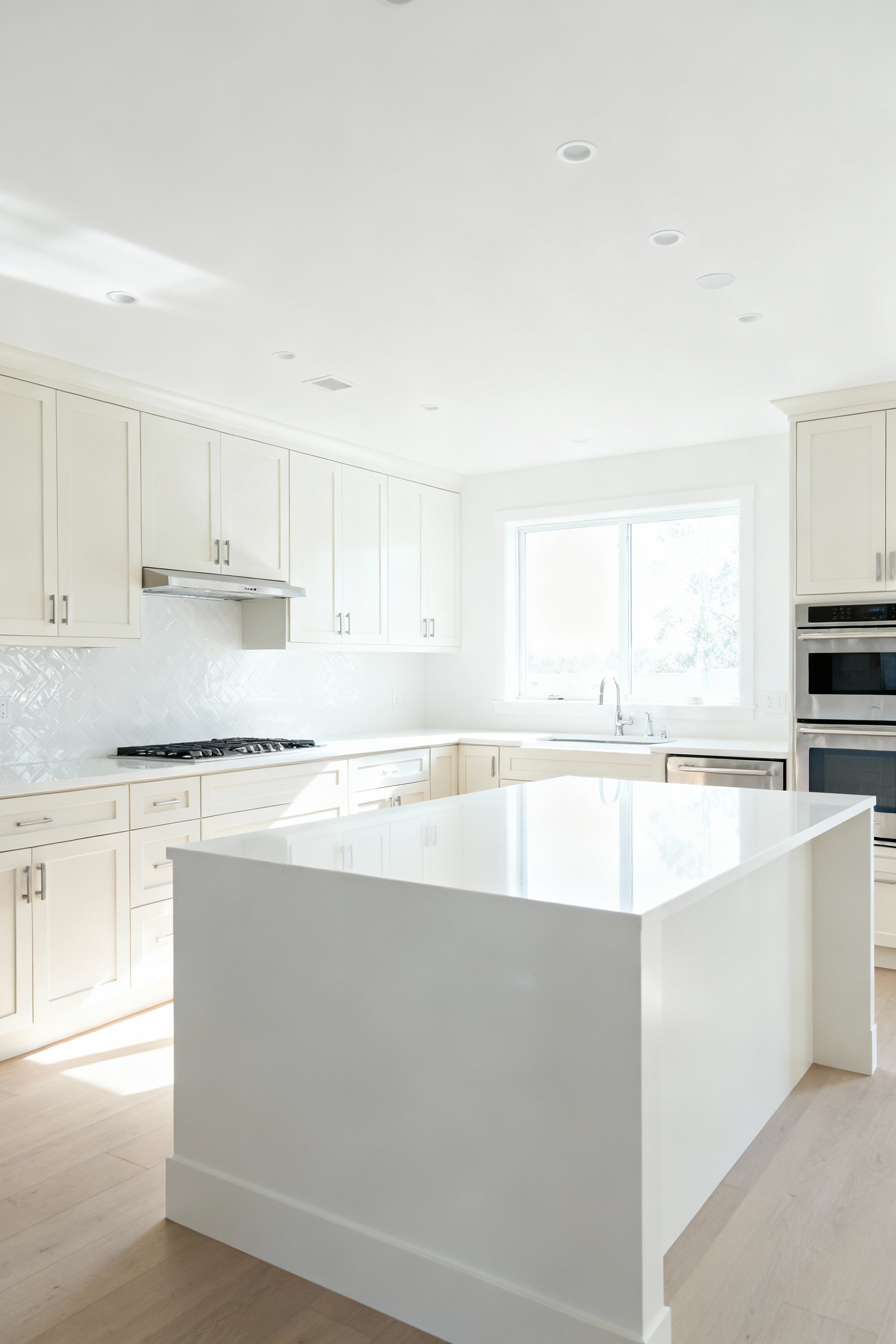
The real magic happens when you layer different whites. Think creamy off-white cabinets against crisp white walls and a marble countertop with soft gray veins. The subtle shifts in tone and texture create depth and sophistication. This isn’t about avoiding color; it’s about using the profound complexity of a single hue to make a space feel both expansive and soulful.
4. Inject Personality with Purposeful Accent Colors
An accent color shouldn’t be an afterthought. It’s a strategic strike of personality. Instead of randomly dotting color around the room, think of your accent as a tool to direct the eye and create an emotional focal point. Maybe it’s a burst of invigorating saffron yellow on the inside of a pantry, a delightful surprise every time you open the door. Or perhaps it’s a row of barstools in a deep, calming sapphire blue, inviting conversation at the island.
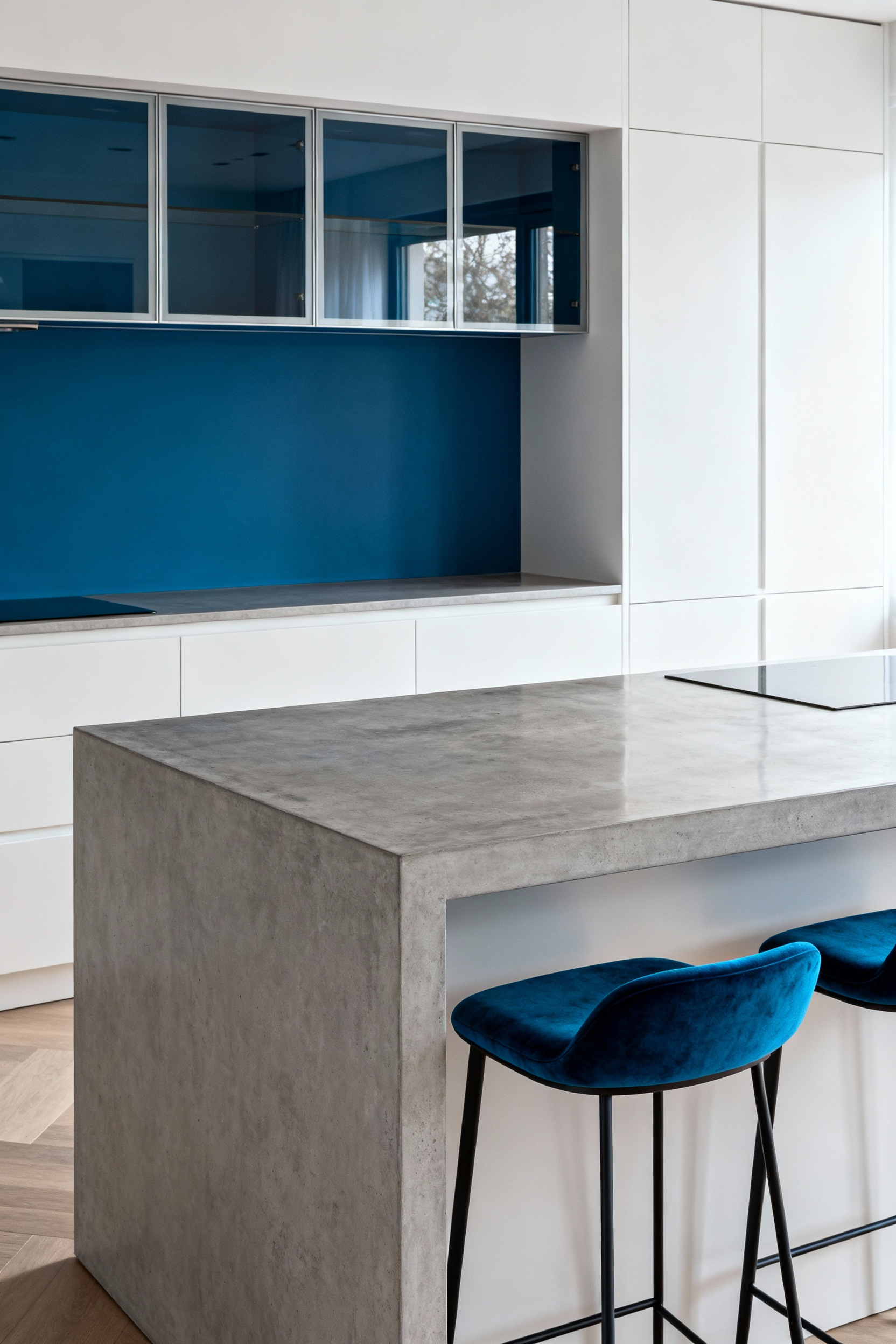
What really gets me is when I see accents that fight the room’s purpose. An accent is your chance to amplify the feeling you want to create. In a kitchen designed for lively family dinners, a splash of energetic coral makes perfect sense. In a minimalist space designed for mindful cooking, a grounding splash of forest green is more psychologically aligned. This is about choosing a color that tells a story, not just one that happens to be trendy.
5. Calibrate Warm vs. Cool Hanes for a Specific Mood
This is the foundational dialect of color psychology. Warm colors (reds, oranges, yellows) are stimulating and advance toward you. They create energy, intimacy, and can even stimulate appetite. Cool colors (blues, greens, purples) are calming and recede from you, creating a sense of spaciousness and tranquility. The question isn’t which is better; it’s what do you want your kitchen to do?
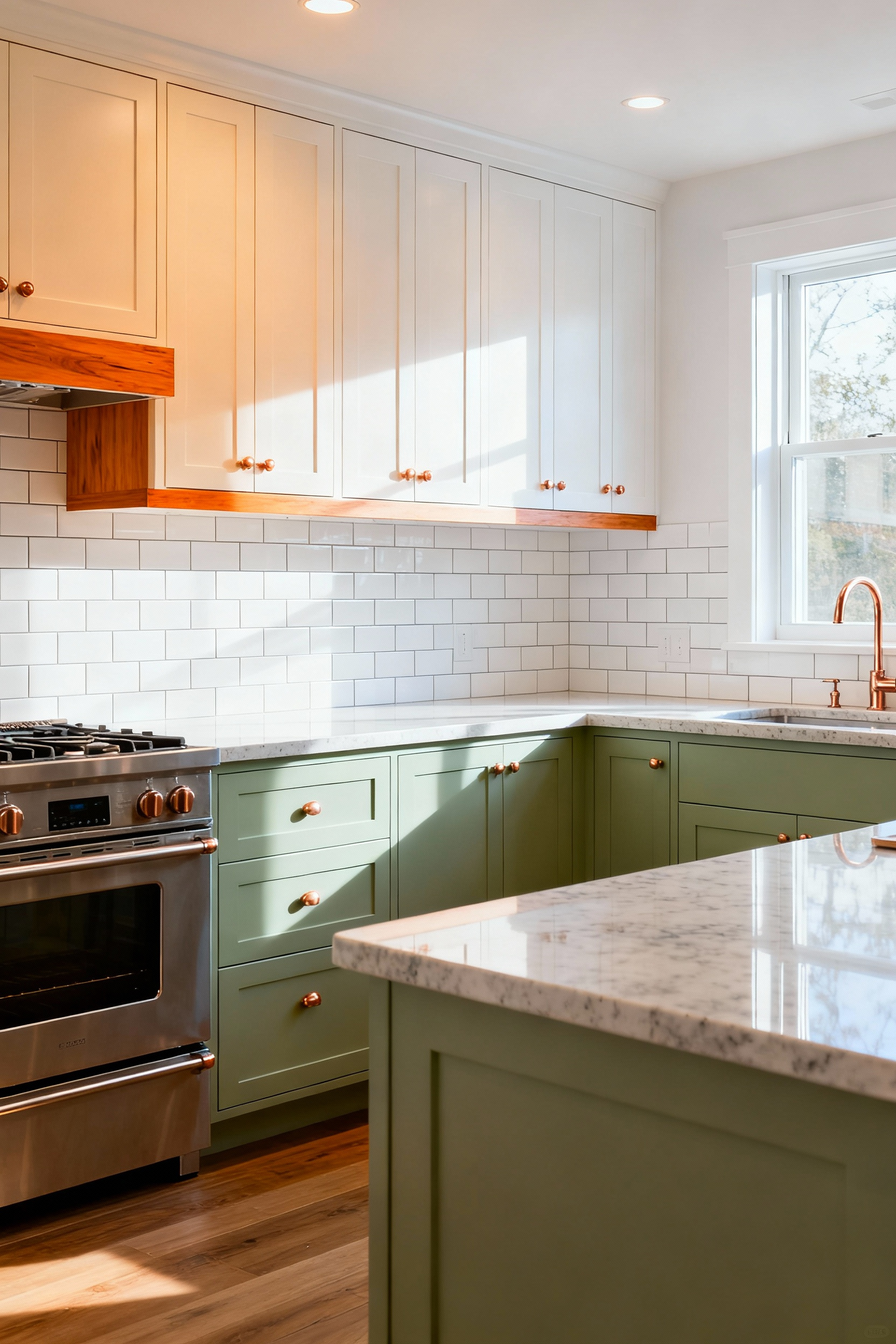
From my work in color theory, the most successful kitchens aren’t purely one or the other. They create a deliberate balance. You might use a calming, cool blue-gray on the main cabinets to create an airy feeling, but introduce warm wood tones on open shelving and a terracotta bowl on the counter to keep the space from feeling clinical. It’s this thoughtful calibration—this conversation between warm and cool—that produces a kitchen that feels balanced, supportive, and dynamic.
Elevating Your Kitchen’s Color Approach
With the fundamentals in place, we can begin to layer in more sophisticated strategies. This is where we move from simply coloring a room to orchestrating an environment.
6. Create Visual Depth with Two-Tone Cabinets
A two-tone cabinet scheme is a brilliant way to add dimension. The classic approach—darker lower cabinets and lighter uppers—works because it mimics the natural world. It grounds the space, creating a sense of stability, while the lighter uppers draw the eye upward, enhancing the feeling of height and airiness. It’s psychologically grounding and visually clever.
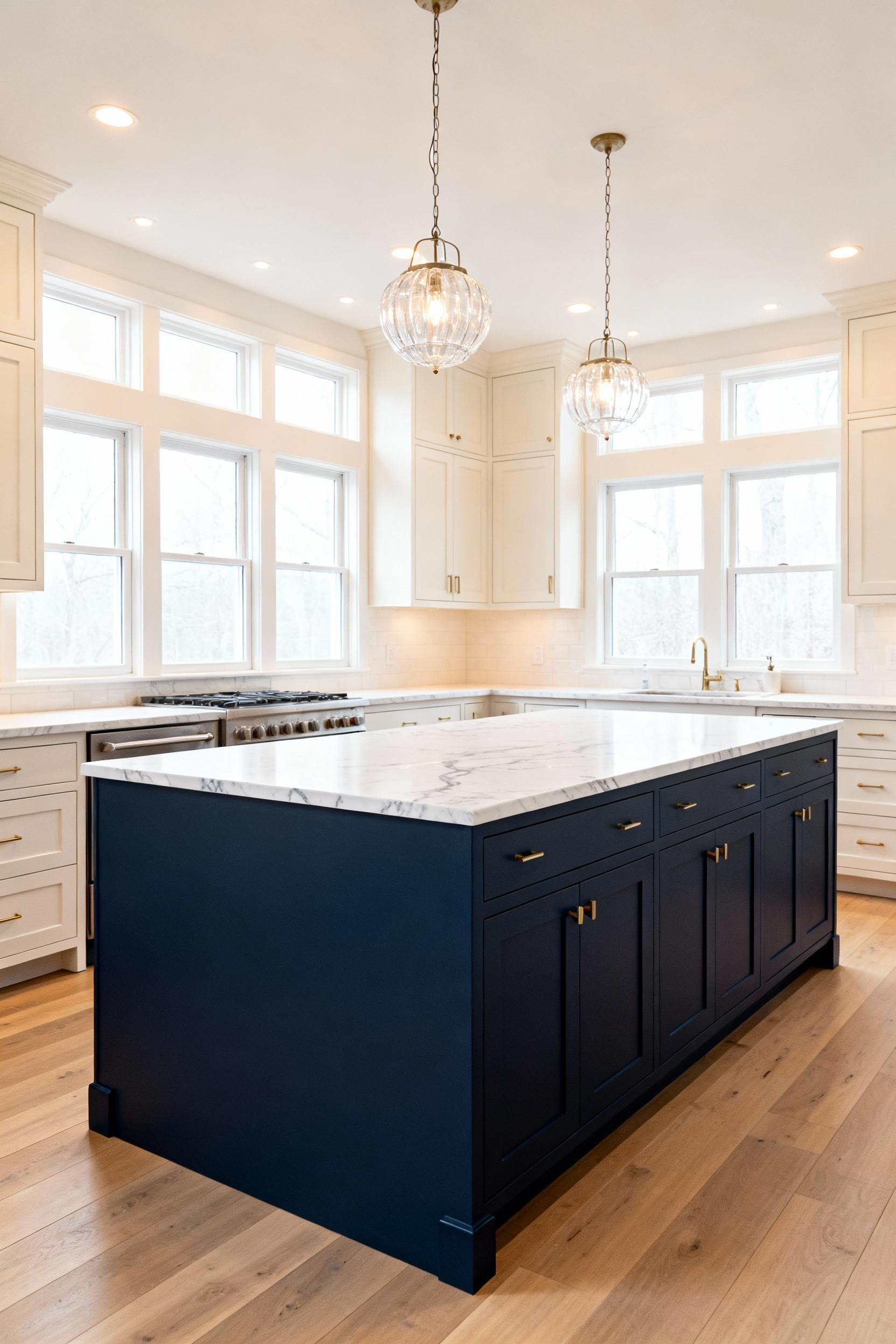
But don’t be afraid to break that rule with intention. In a kitchen with very high ceilings, flipping the script with darker uppers can create a dramatic, cozy effect, drawing the ceiling down for a more intimate feel. The key is to ensure both colors share a compatible undertone to maintain harmony. A cool, deep navy on the bottom paired with a crisp, cool white on top feels cohesive. That same navy paired with a warm cream? It might just look like a mistake.
7. Make the Backsplash Your Emotional Centerpiece
Your backsplash is prime real estate for making an emotional statement. It’s an opportunity to inject a dose of powerful color psychology without committing to an entire room of a bold hue. Do you want your kitchen to be a place of calm focus? A backsplash of serene sage green or soft blue tile can act as a visual anchor for tranquility, a place for your eyes to rest while you chop and stir.
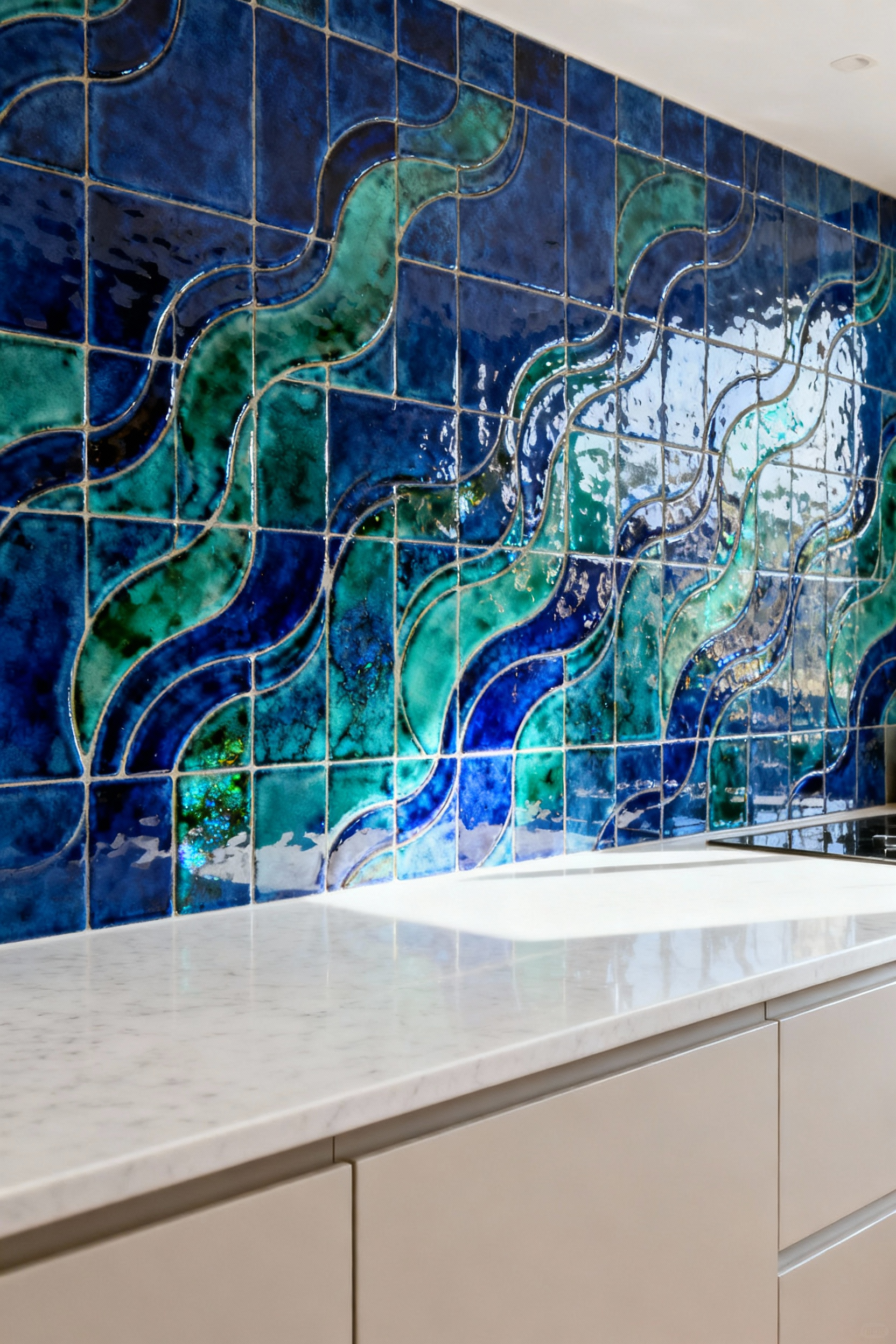
Conversely, if your kitchen is the energetic heart of the home, a backsplash in a vibrant, warm terracotta or a cheerful yellow can radiate energy and conviviality. I learned this when designing a kitchen for a young family who loved to entertain. We used a neutral palette on the cabinets but installed a backsplash of handmade Zellige tiles in a rich, spicy ochre. It completely transformed the room’s energy, turning it into a warm, buzzing hub for every gathering.
8. Explore the Nuance of a Monochromatic Scheme
Monochromatic does not mean boring. When done right, it is the absolute height of sophistication. The secret is to think in textures, not just colors. A kitchen designed in various shades of grey can be breathtakingly beautiful if you orchestrate a symphony of materials.
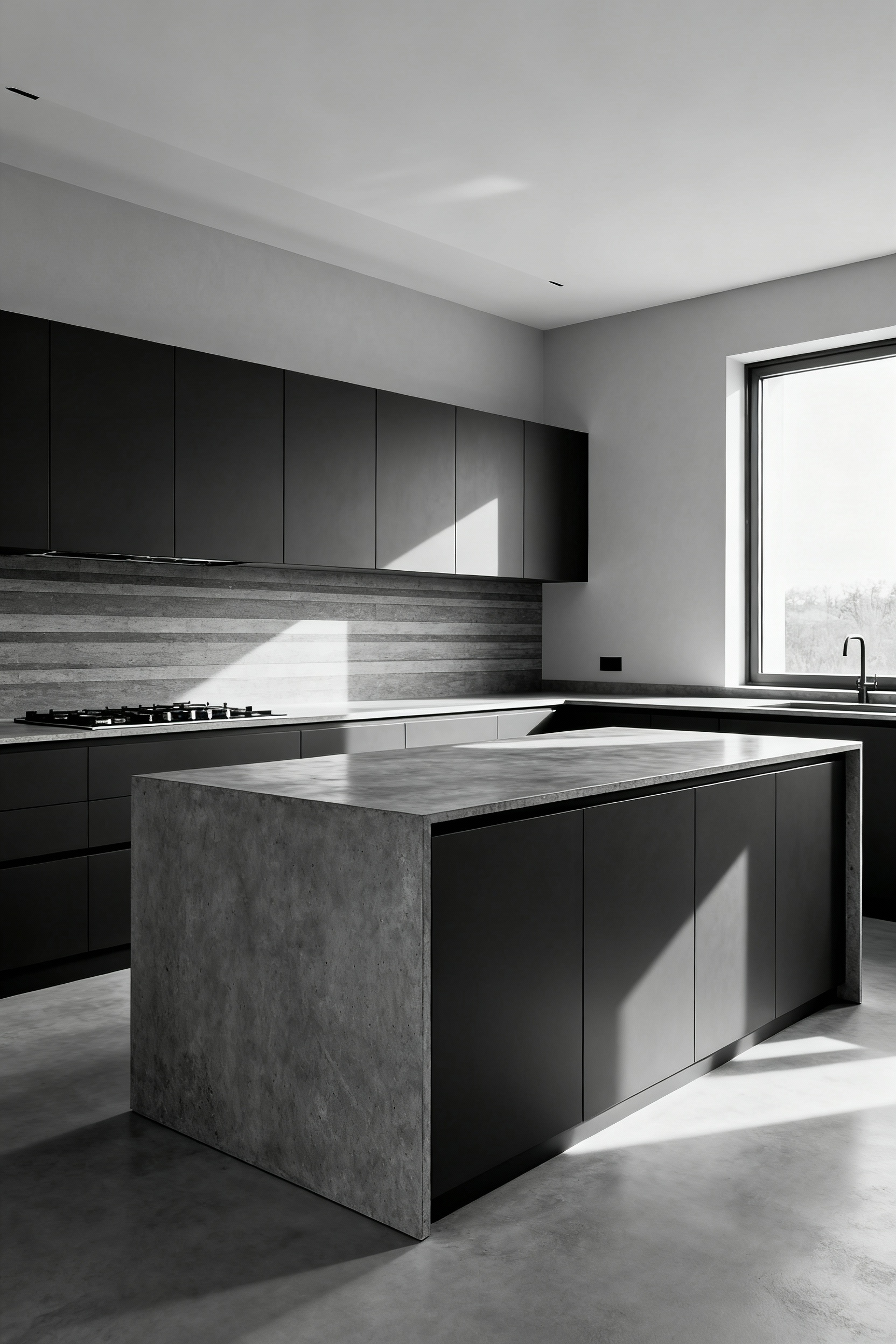
Imagine this: matte, dark charcoal cabinets, a honed light-grey soapstone countertop that feels like silk, a backsplash of polished silver-grey ceramic tile that catches the light, and a floor of weathered grey wood. Every element is in the same color family, but the variation in texture and light reflection creates a rich, layered experience. You’re inviting touch as much as sight, crafting a space that feels deeply considered and calming to the senses.
9. Weave in “Textural Colors” for Sensory Richness
Every material has an inherent color that goes beyond its hue. The warm, variegated pattern of a butcher block countertop is a color. The cool, sleek reflection of stainless steel is a color. The soft, light-absorbing quality of a honed slate floor is a color. These are what I call ‘textural colors,’ and integrating them is essential for preventing visual monotony.
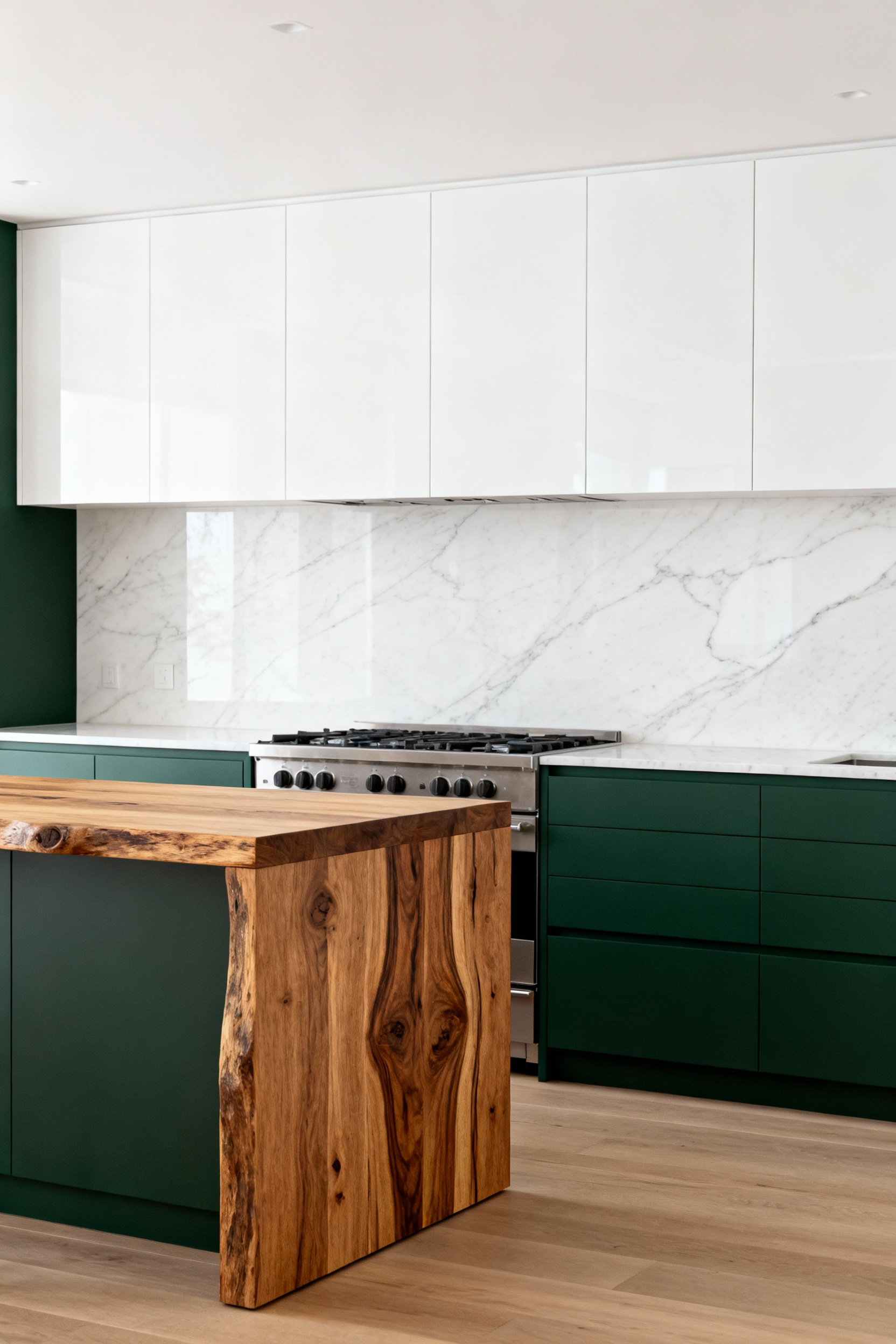
These materials serve as bridges and breaks in your palette. In an all-white kitchen, the introduction of warm wood shelving, brass hardware, and a few linen textiles provides the necessary warmth and visual interest to keep it from feeling clinical. Actively choosing materials for their sensory contribution, not just their primary hue, is a professional-level move that makes a space feel layered and alive.
Advanced Color Strategies
Ready to move beyond the conventional? These strategies are about using color to solve architectural problems, manipulate perception, and create a truly custom environment.
10. Amplify Small Kitchens with Illusionary Color
In a small kitchen, color is your best tool for architectural illusion. The goal isn’t just to make it look bigger, but to make it feel better. Cool colors like pale blues, greens, and soft grays naturally recede from the eye, creating an immediate sense of spaciousness. Pair these hues with a semi-gloss or satin finish on the cabinets to bounce light around, further enhancing the effect.

But here’s a more advanced trick: paint the ceiling the same color as the walls, or even a shade lighter. This blurs the boundary between wall and ceiling, making the eye travel upwards and creating an illusion of greater height. Avoid high-contrast schemes that chop up the space. Instead, a seamless, light, and cool palette creates a calming, airy bubble that feels expansive and serene.
11. Sidestep Visual Monotony with Smart Variation
A perfectly matched room can be strangely unsettling. Our brains crave a degree of visual complexity. When every surface is the exact same hue and finish, the space can feel flat and lifeless. The antidote is not chaos, but controlled variation.
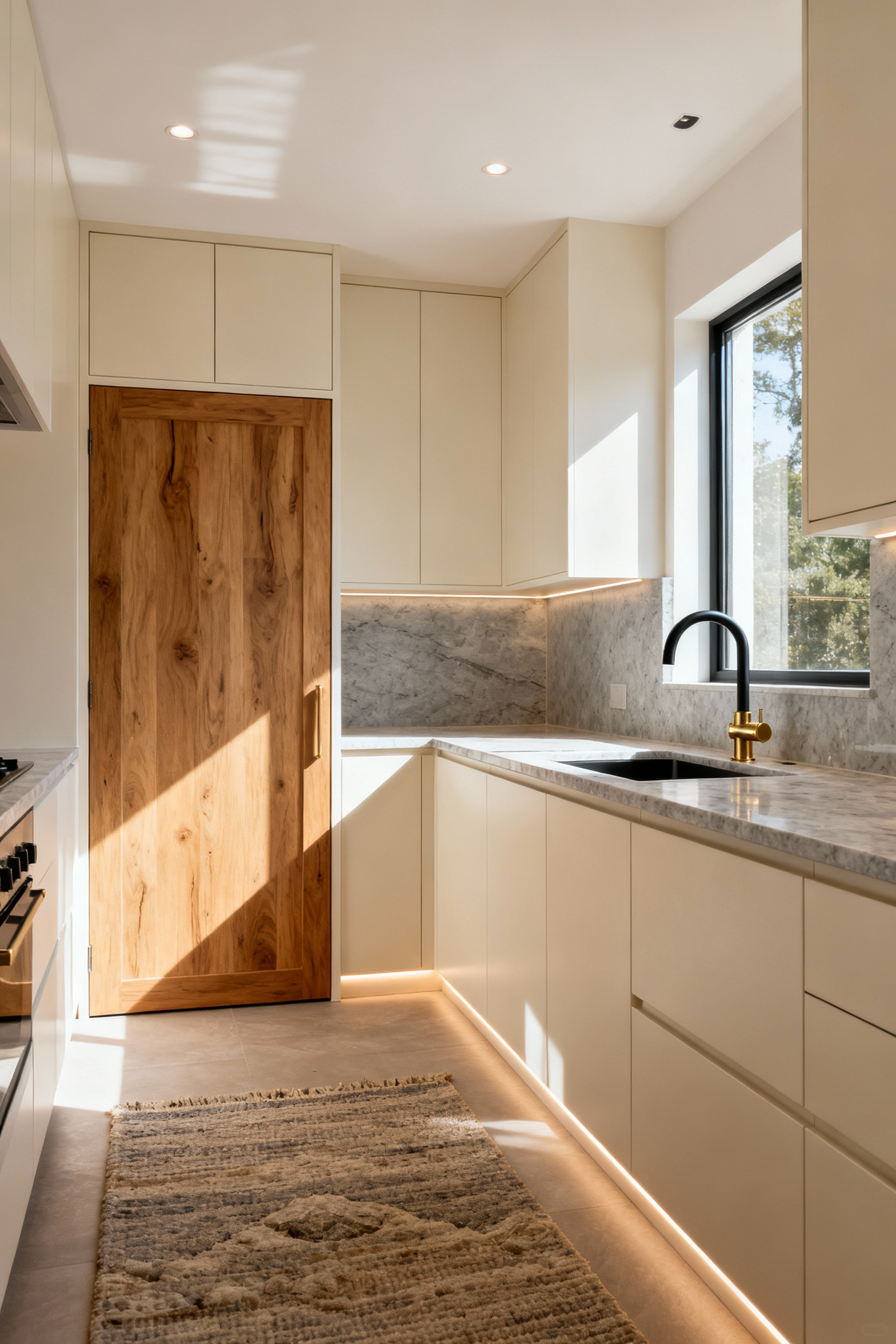
Even within a very tight color palette, you can introduce variation through finish. Imagine an all-black kitchen. If the cabinets are a super-matte Fenix finish, the countertops are a polished black granite, and the backsplash is a glossy black tile, the room will feel dynamic and incredibly chic. The single color is interpreted differently by each surface as it reflects or absorbs light. This subtle, sophisticated approach to variation is what separates good design from truly great design.
12. Unify Your Space with a Floor-to-Wall Color Connection
The relationship between your floor and your walls defines the entire envelope of your kitchen. A harsh disconnect between them can visually fracture the room. To create a seamless, harmonious flow, ensure the undertones of your flooring and wall color are in conversation. A warm, yellow-toned oak floor will always look better with a warm white or greige on the walls than with a stark, blue-toned gray.
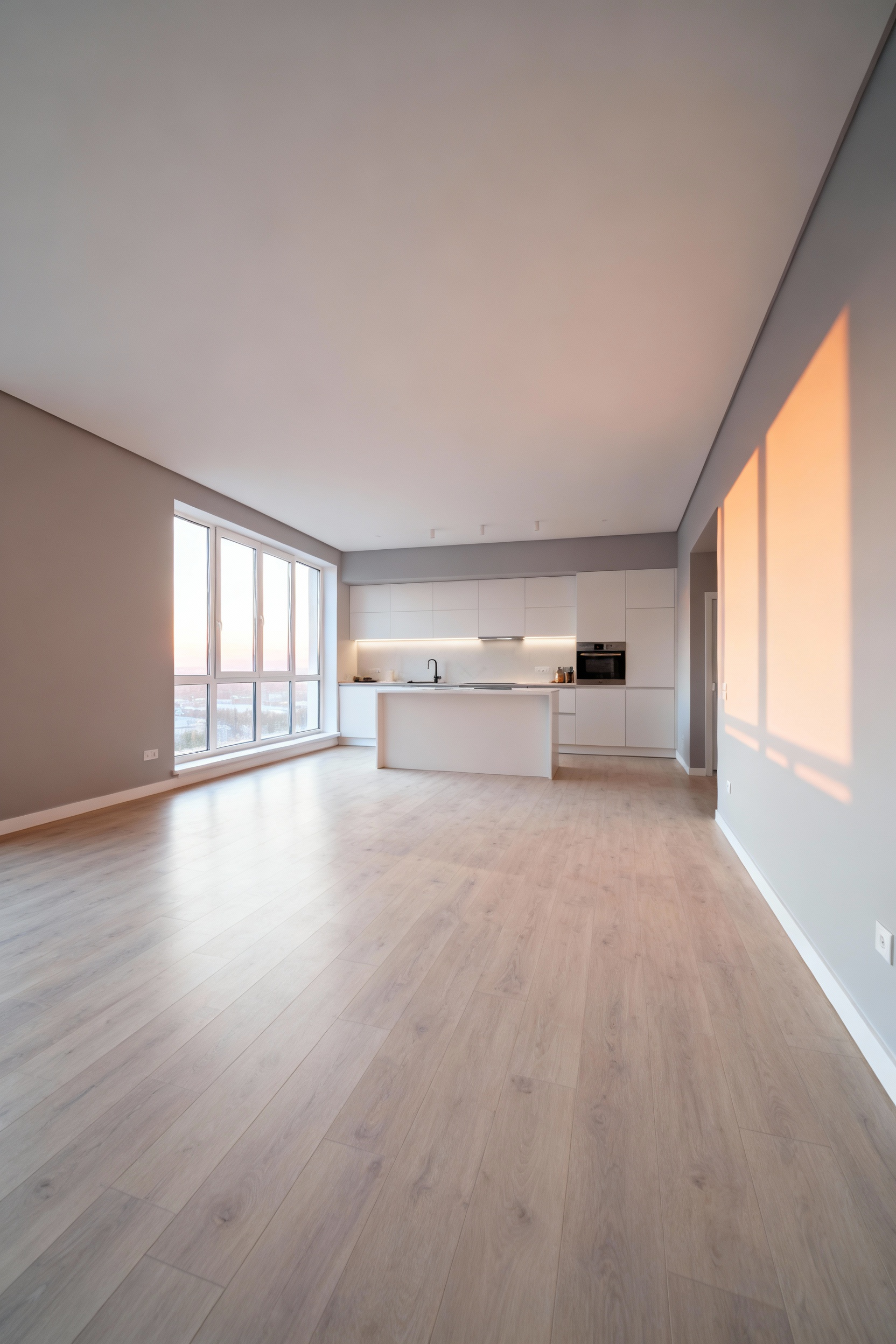
For a grounded, psychologically reassuring feel, select a flooring that is a few shades darker than your main wall or cabinet color. This creates a sense of stability, anchoring the room. Conversely, a floor that closely matches the wall color can create a chic, gallery-like effect—an immersive color experience that works beautifully in modern or minimalist spaces.
Expert Color Integration
This is the pinnacle—where color choice becomes a holistic practice of tailoring an environment to a specific human experience.
13. Light Your Colors Properly with a Full-Spectrum System
You can devise the most perfect color palette in the world, but if your lighting is wrong, it will fail. Most standard LED or fluorescent bulbs cast a strong yellow or blue light that completely distorts color. That sophisticated sage green on your cabinets can turn a sickly yellow-green under the wrong bulbs. This is why a chromatically balanced, full-spectrum lighting design is non-negotiable.
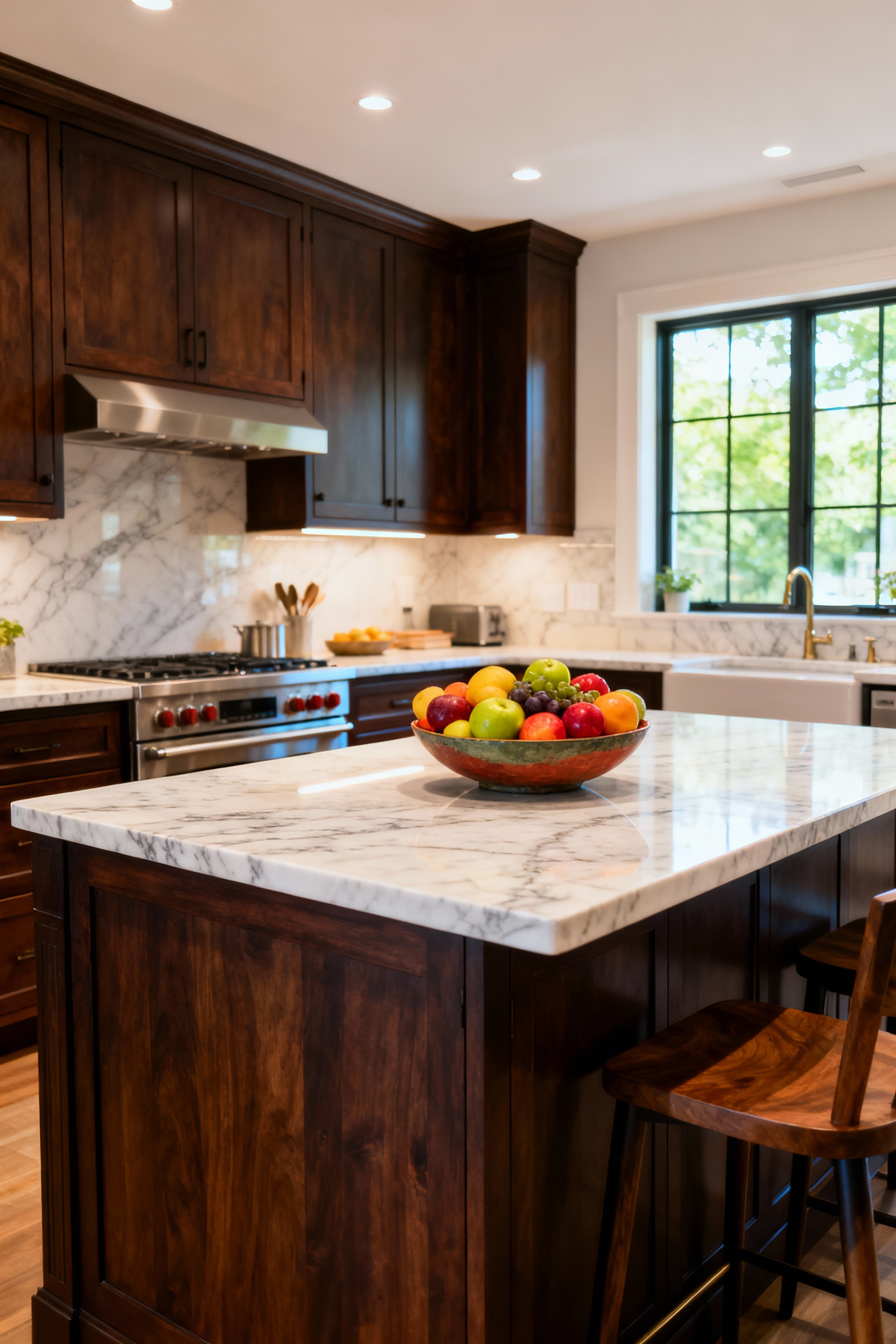
Here’s what I tell my clients: look for bulbs with a high Color Rendering Index (CRI)—90 or above is the professional standard. This means the light source will render colors truthfully, just like natural daylight. You need to layer this lighting: ambient (overall), task (under cabinets), and accent (in glass-front cabinets or on artwork). When your light sources present color accurately, your entire design comes to life exactly as you intended, day or night.
14. Let Your Home’s Architecture Guide Your Palette
Your home’s architectural style has its own chromatic language. Fighting it creates a subtle but persistent feeling of discord. A better approach is to deconstruct that style and create a historically sympathetic palette that enhances the home’s inherent character. This isn’t about creating a museum; it’s about being in dialogue with your home’s DNA.
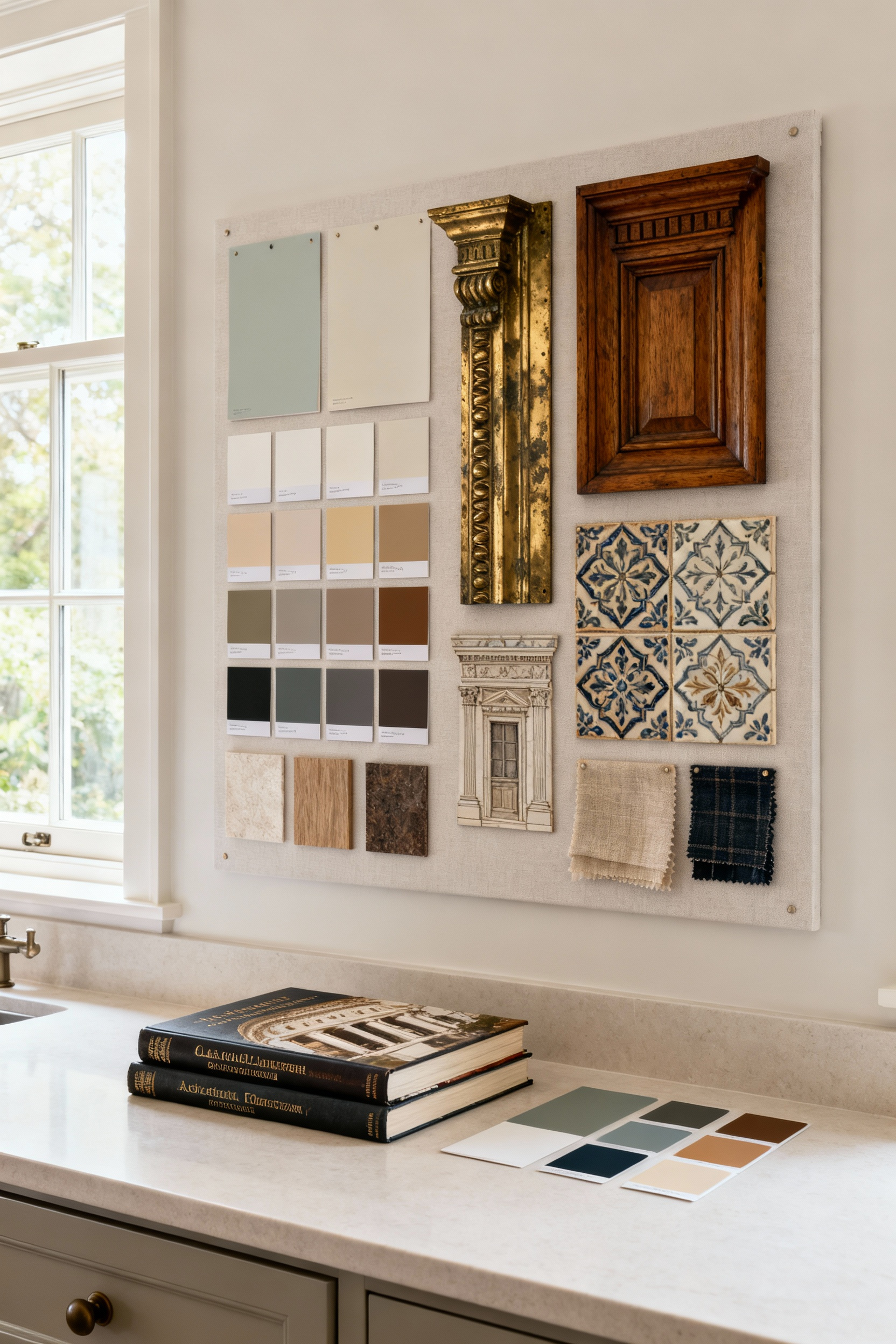
A Craftsman-style home, with its emphasis on natural materials and craftsmanship, calls for earthy greens, warm ochres, and deep wood tones. A Mid-Century Modern kitchen, on the other hand, sings with a palette of optimistic avocado, warm teak, and crisp white. By using the architecture as your guide, you create a kitchen that feels deeply rooted and timeless—a natural extension of the home’s soul.
15. Engineer Emotion with High-Contrast Anchors
Want to create a bit of drama and direct the eye? Use a high-contrast visual anchor. This is a powerful psychological tool that establishes a focal point and injects energy. Think of a dark, moody charcoal island in an otherwise all-white kitchen. It immediately becomes the room’s gravitational center, a confident and grounding statement.
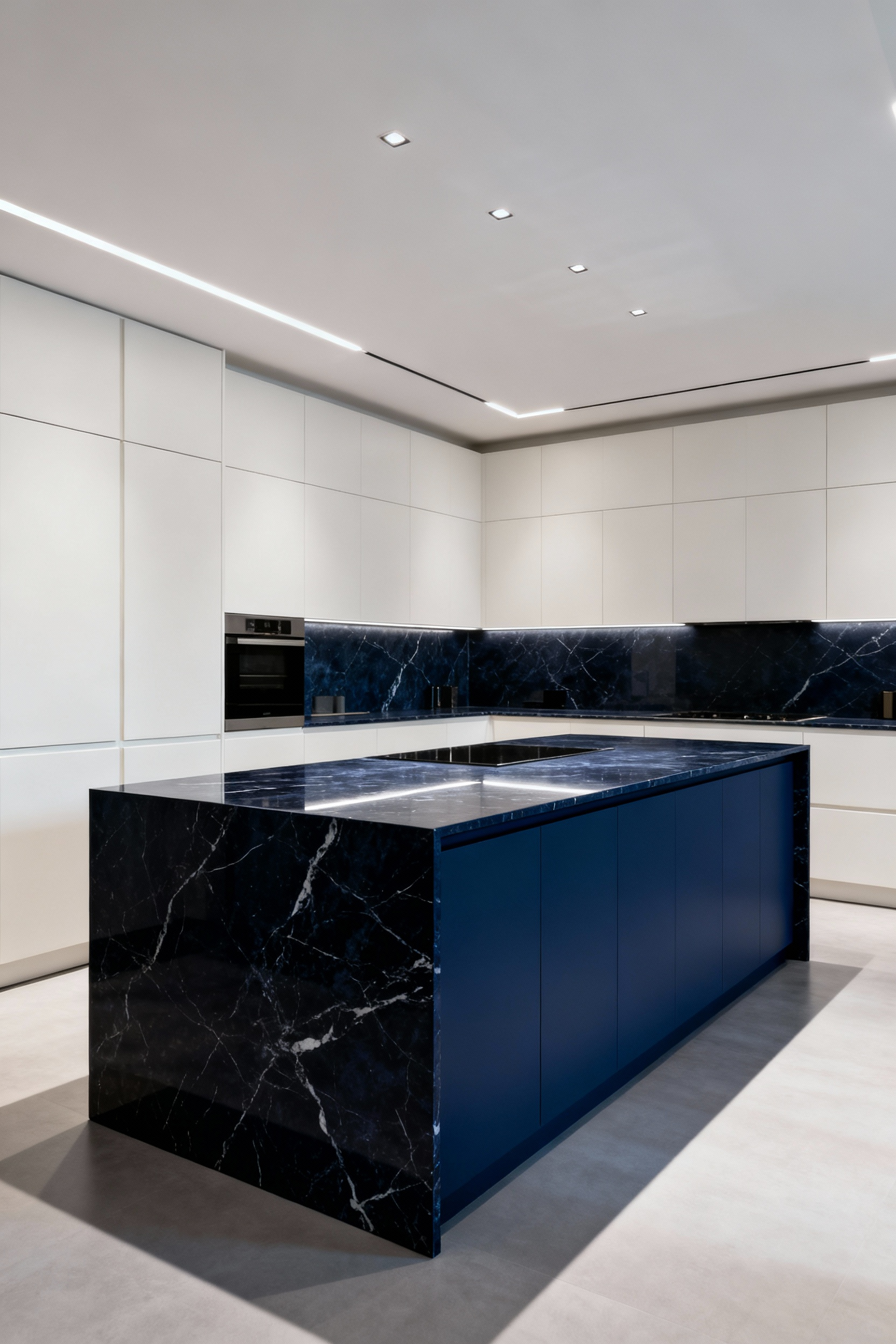
This technique is about creating controlled tension. It breaks up monotony and adds a layer of sophistication. It could be a vibrant, fire-engine red range hood in a sleek gray kitchen, or a back wall of exposed brick against smooth, minimalist cabinetry. You’re giving the eye a definitive place to land, creating a sense of order and purpose amidst the various elements of the kitchen.
16. Apply the 60-30-10 Rule for Perfect Balance
The 60-30-10 rule is a timeless design principle for a reason: it works. It creates a sense of visual equilibrium that is inherently pleasing.
- 60% is your dominant color: Usually the walls and major cabinet runs. This color sets the overall mood.
- 30% is your secondary color: This could be an island, a section of cabinetry, or flooring. It should support the main color and add interest.
- 10% is your accent color: Think hardware, lighting fixtures, bar stools, or art. This is your pop of personality.
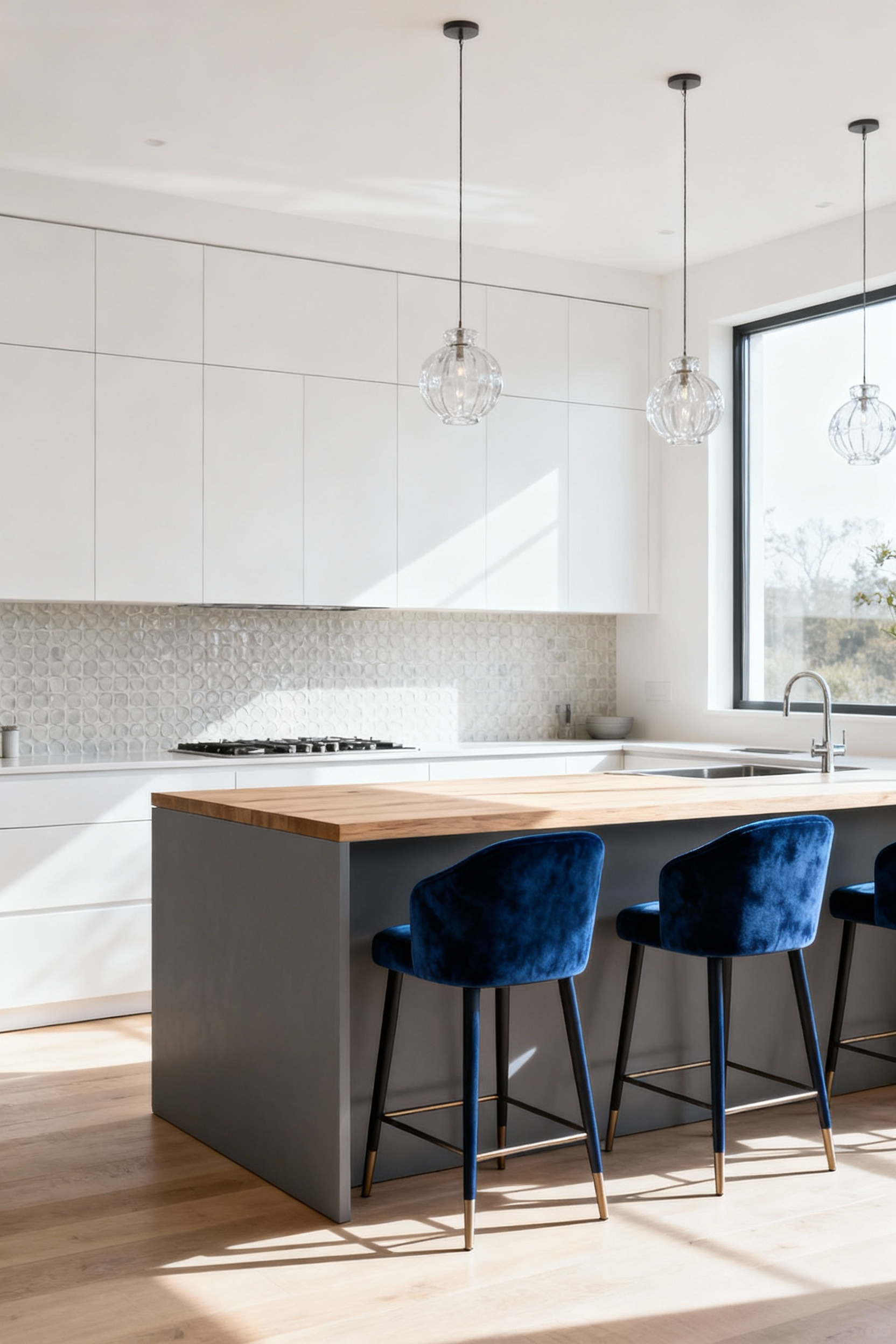
This isn’t a rigid formula, but a brilliant guide. It prevents you from creating a space that feels either too chaotic or too monotonous. By consciously assigning your colors to these proportions, you ensure that every hue has a clear role, contributing to a final composition that feels balanced, intentional, and complete.
17. Tailor Color for Bespoke Well-being
At its most profound level, color selection is a tool for personalized well-being. Move beyond generic associations (blue is calm, yellow is happy) and ask: how do I want to feel in this space? If you find the process of cooking to be a stressful but necessary chore, surrounding yourself with calming, focusing colors like soft greens and deep blues can transform the experience into something more meditative.
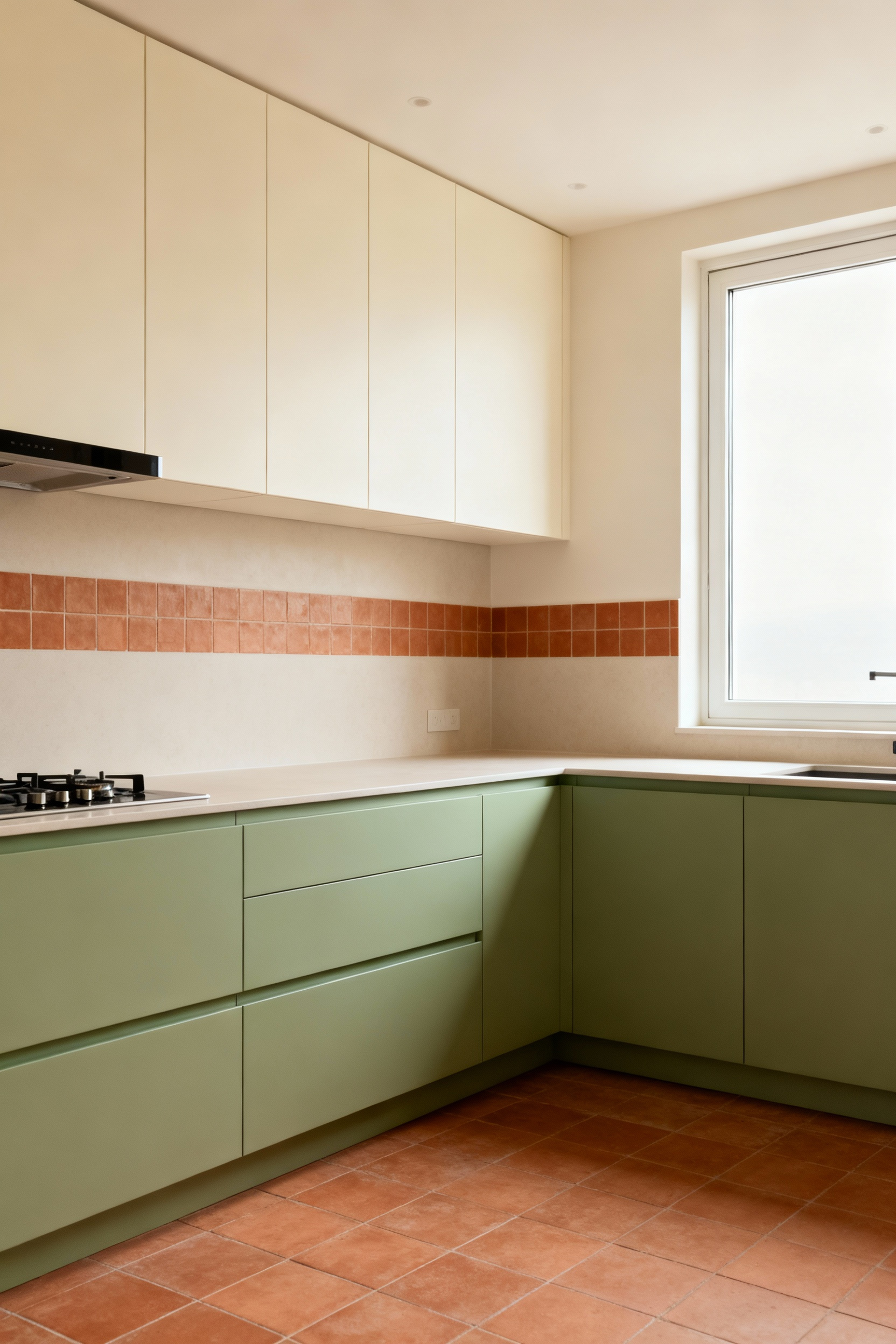
If your kitchen is the chaotic but joyful hub of family life, lean into warm, energetic colors like terracotta, ochre, or even a soft coral to foster communication and connection. In my color psychology specialist practice, I spend the first session not talking about color, but about lifestyle, routines, and emotional goals. The right palette isn’t about what’s in a magazine; it’s a bespoke prescription for a better daily life.
18. Sculpt the Room with Color Blocking
Color blocking isn’t just for fashion; it’s a brilliant architectural tool for kitchens. Use it to define functional zones without putting up walls. You could paint an entire alcove that houses your coffee bar a deep, energizing espresso color, creating a distinct “moment” and visually separating it from the main cooking area.
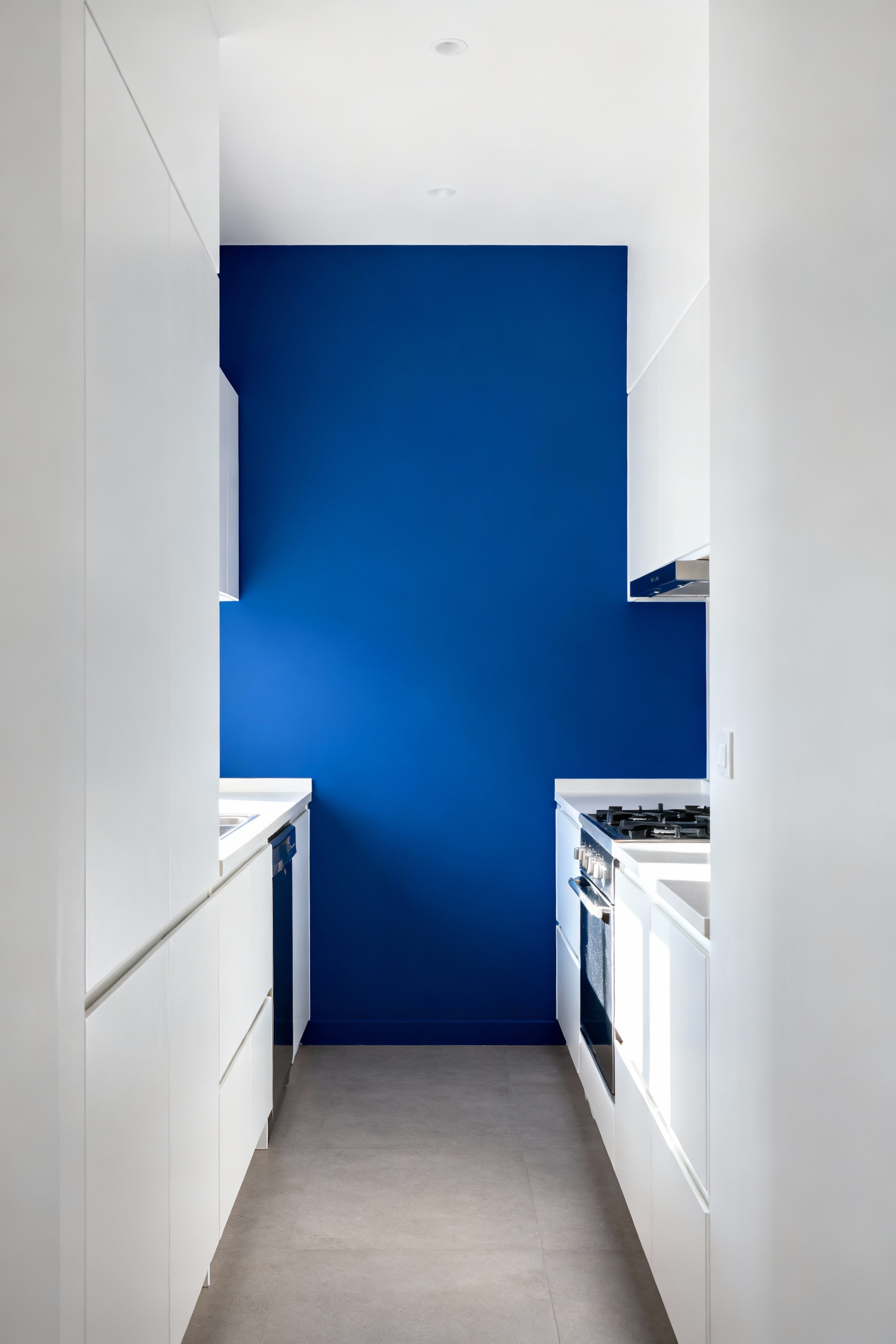
This technique is also fantastic for manipulating perception. In a long, narrow galley kitchen, painting the far end wall a darker, more saturated color will make it advance toward you, helping the space feel less like a corridor. You are literally using color to redraw the dimensions of your room, creating more pleasing proportions and better-defined functional areas.
19. Leverage Reflective Surfaces to Animate Your Color
Think of reflective surfaces—a high-gloss backsplash, polished chrome hardware, a gleaming stone countertop—as active participants in your color scheme. They don’t just sit there; they catch, bend, and amplify the light and color around them, creating a dynamic, ever-changing environment.
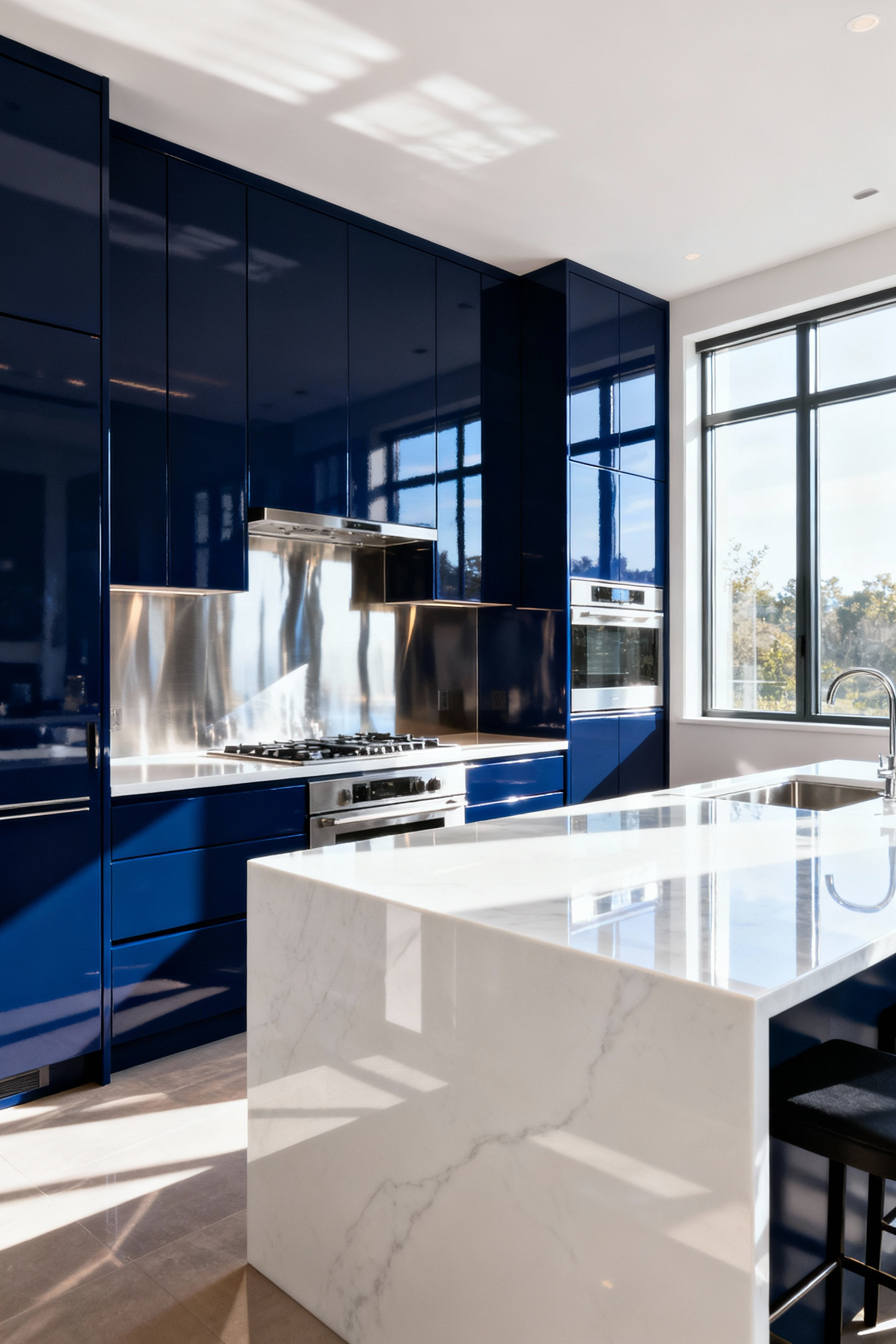
In a kitchen with deep, moody colors like charcoal or navy, introducing these reflective elements is critical. They prevent the dark hues from feeling flat or oppressive by creating points of light and vibrancy. They capture the color of the flowers on your counter or the blue of the sky outside the window, weaving these fleeting moments into the fabric of your design. They make the space feel animated and alive.
20. Future-Proof Your Palette for Enduring Appeal
The fear of choosing a color that will quickly look dated is real. The way to cultivate enduring appeal is to differentiate between your permanent investments and your easily changed elements. For your foundational pieces—cabinetry, countertops, flooring—choose a palette rooted in classic design. This doesn’t have to mean neutral; a deep forest green or a classic navy blue have a timeless quality that transcends trends.
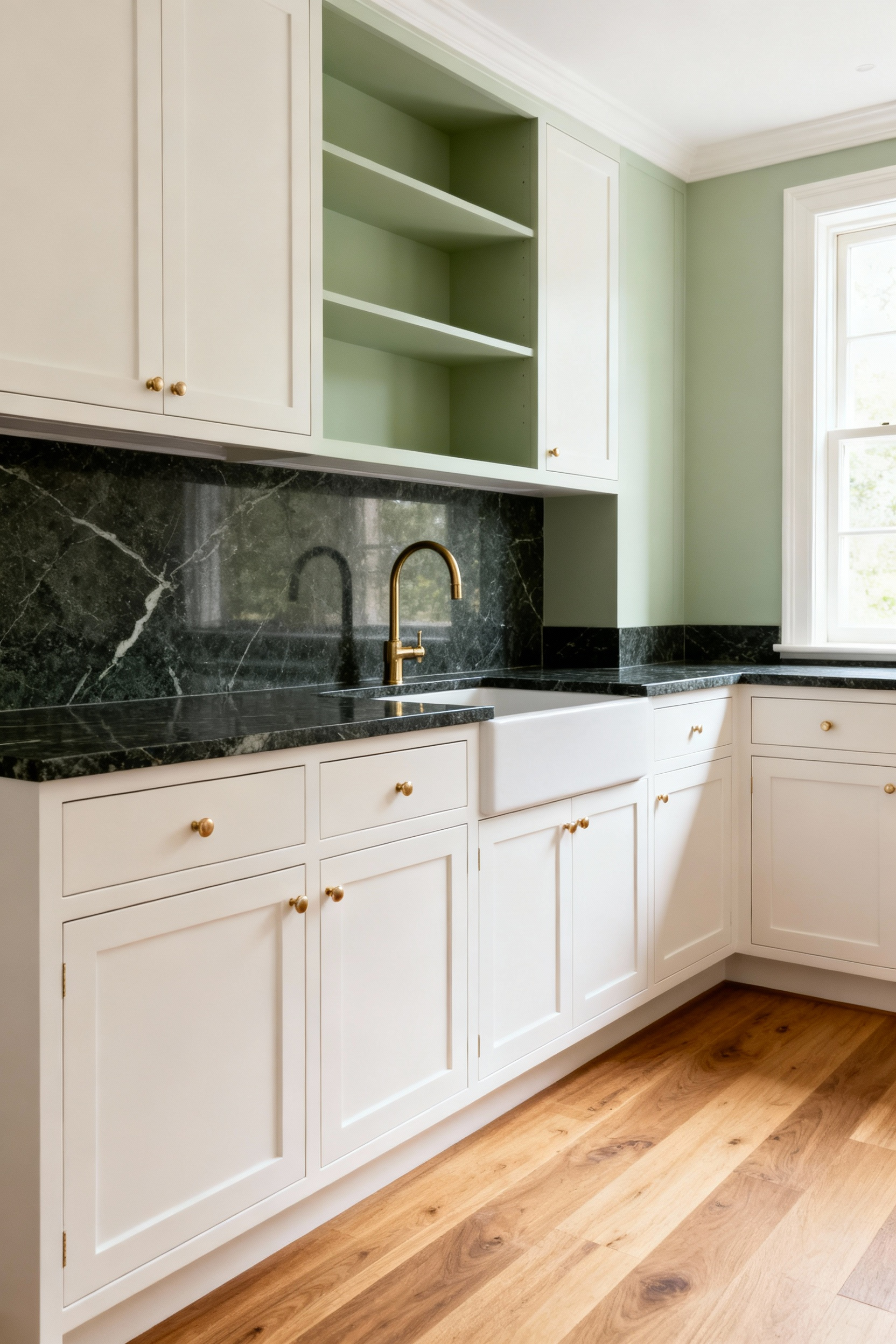
Save the more ephemeral, trendy colors for things that are easy and inexpensive to swap out. Paint that small accent wall, buy the bright red kettle, choose vibrant-colored dish towels. This two-track approach allows your kitchen to have a timeless, solid core while still giving you the flexibility to play with trends and express your evolving personality over the years. It’s the ultimate strategy for a kitchen that lasts.
Conclusion
We started by pushing back against the ‘safe’ and sterile kitchen, and hopefully, I’ve shown you that color is so much more than decoration. It is a language. Choosing a color palette for your kitchen is an act of intention—a way to architect an environment that actively supports your well-being, inspires your creativity, and welcomes the people you love.
You now have a framework for thinking about kitchens color ideas not as a series of swatches, but as a holistic system where light, texture, psychology, and architecture work in concert. The power is now in your hands. I challenge you to look at your own kitchen with new eyes—not as a room to be decorated, but as a space to be felt. Be bold, be thoughtful, and create a kitchen that doesn’t just function beautifully, but feels truly, authentically like home.
